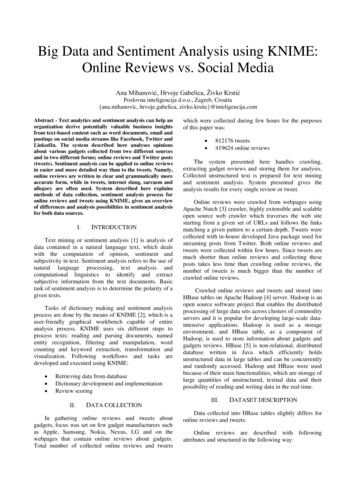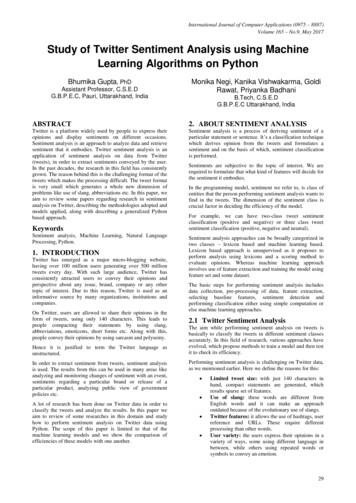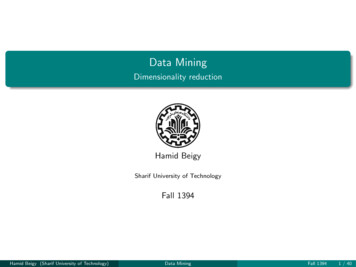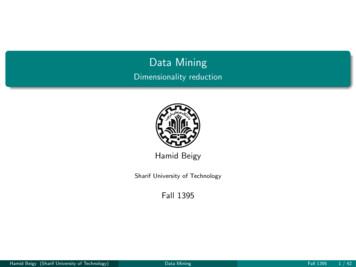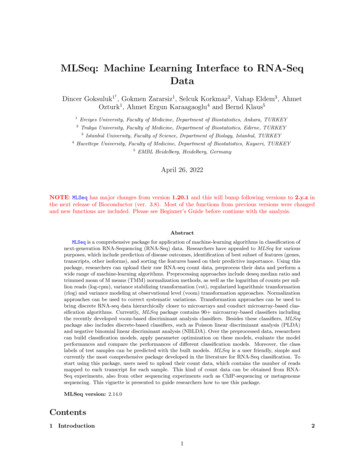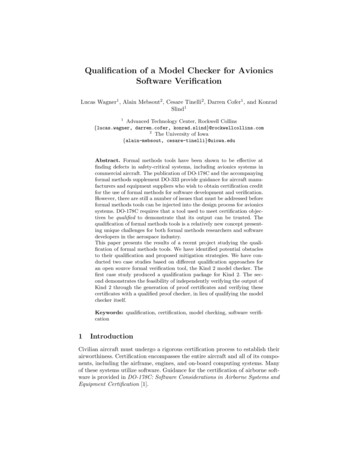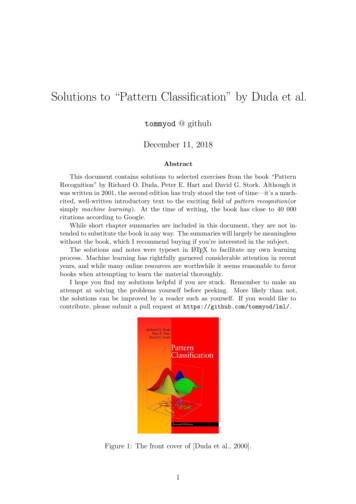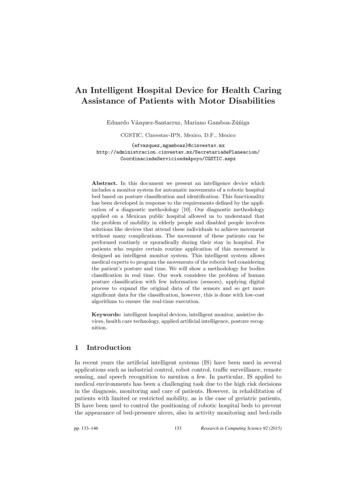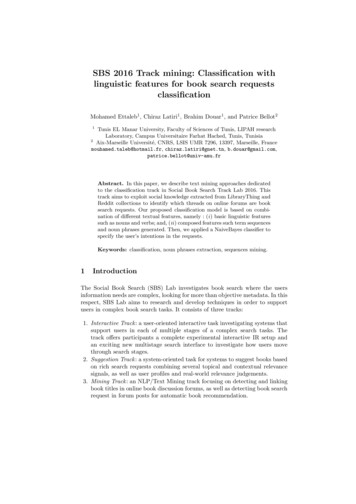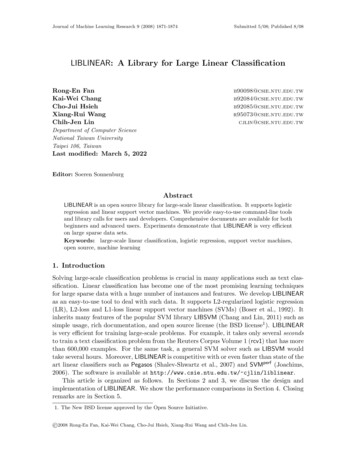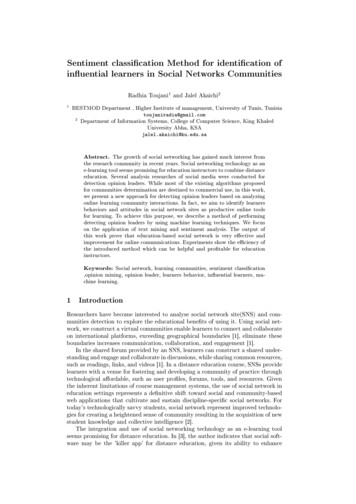
Transcription
Sentiment classi cation Method for identi cation ofin uential learners in Social Networks CommunitiesRadhia Toujani1 and Jalel Akaichi21BESTMOD Department , Higher Institute of management, University of Tunis, Tunisia2toujaniradia@gmail.comDepartment of Information Systems, College of Computer Science, King KhaledUniversity Abha, KSAjalel.akaichi@ku.edu.saAbstract. The growth of social networking has gained much interest fromthe research community in recent years. Social networking technology as ane-learning tool seems promising for education instructors to combine distanceeducation. Several analysis researches of social media were conducted fordetection opinion leaders. While most of the existing algorithms proposedfor communities determination are destined to commercial use, in this work,we present a new approach for detecting opinion leaders based on analyzingonline learning community interactions. In fact, we aim to identify learnersbehaviors and attitudes in social network sites as productive online toolsfor learning. To achieve this purpose, we describe a method of performingdetecting opinion leaders by using machine learning techniques. We focuson the application of text mining and sentiment analysis. The output ofthis work prove that education-based social network is very e ective andimprovement for online communications. Experiments show the e ciency ofthe introduced method which can be helpful and pro table for educationinstructors.Keywords: Social network, learning communities, sentiment classi cation,opinion mining, opinion leader, learners behavior, in uential learners, machine learning.1IntroductionResearchers have become interested to analyse social network site(SNS) and communities detection to explore the educational bene ts of using it. Using social network, we construct a virtual communities enable learners to connect and collaborateon international platforms, exceeding geographical boundaries [1], eliminate theseboundaries increases communication, collaboration, and engagement [1].In the shared forum provided by an SNS, learners can construct a shared understanding and engage and collaborate in discussions, while sharing common resources,such as readings, links, and videos [1]. In a distance education course, SNSs providelearners with a venue for fostering and developing a community of practice throughtechnological a ordable, such as user pro les, forums, tools, and resources. Giventhe inherent limitations of course management systems, the use of social network ineducation settings represents a de nitive shift toward social and community-basedweb applications that cultivate and sustain discipline-speci c social networks. Fortoday's technologically savvy students, social network represent improved technologies for creating a heightened sense of community resulting in the acquisition of newstudent knowledge and collective intelligence [2].The integration and use of social networking technology as an e-learning toolseems promising for distance education. In [3], the author indicates that social software may be the 'killer app' for distance education, given its ability to enhance
2Radhia Toujani and Jalel Akaichisocial presence. The creation of social networking around academic topics providesinstructors and students great exibility for teaching and learning[2].In this paper, we propose a method to detect in uential learners in the social networks. At the rst step, the extraction and the collection of the raw data are explained. Then, the process of sentiment analysis of online learning communities andthe detection of opinion leader are discussed.The rest of this paper is organized as follows. Section 2 discusses the relatedworks; Section 3 presents the research framework; Section 4 presents experimentalresults; in Section 5, concludes the paper with some suggestion for future researchdirections.2Related worksSocial networks analysis has recently gained more importance thanks to its application in elds such as sociology. Many researchers are interested on identi cationof opinion leaders. So far, some researchers were studied on opinion leaders whererst of them is situated within the eld of sociology. Numerous studies such as[5][10][16] have been conducted in order to understand the concept of opinion andcharacteristics of leaders distinguishing them of their followers.The studies on opinion leader identi cation can be divided into two parts. First,the link-based opinion leader identi cation methods that consider the social interactive structure of the network. Second, the mixture of opinion leader identi cationmethods that combine the social link information with semantic-based informationembodied in documents [9][12][15].As an example of link-based opinion leader selection, the authors in[4] have identi ed opinion leaders with an excellent edge rank algorithm based on excellent network theory, applied it to rank excellent edges and used the ranking result to identify opinion leaders in opinion excellent network model. Alternatively, researchers in[11][13][17] have proposed an improved combined framework identifying the opinionleader in online learning communities, which ranked opinion leaders based on fourdistinguishing features: expertise, novelty, in uence, and activity. Furthermore, theperformances of opinion leaders were further investigated in terms of longevity andcentrality.Also, in[8] [6], authors have found that those opinion leaders are the optimummarketing choice in terms of di usion speed and maximum cumulative number ofadopters, used a social network method and threshold model and conclude thatopinion leaders with a high sociality and centrality (users who have high degree ofconnections to other people) are the best ones for fast di usion.In case of social network, many of the trust of customers to the social networkcommunities are based on opinion leaders' recommendations for products and services [7][18]. So, how to identify the opinion leaders e ectively is the key to raisesales and brand awareness. In sales and marketing eld, some studies focus on developing various indexes such as in-degree, out-degree, betweenness and closeness insocial network analysis to identify opinion leaders. These studies are interested inidentifying opinion leaders who will forward be marketing messages to other usersvia their trust and distrust networks.3METHODOLOGYThis section presents our methodology. Firstly, the general architecture is presented.Secondly, the extraction and the collection of the raw data are explained. Then, theprocess of sentiment analysis of online learning communities and the detection ofopinion leader are discussed.
Title Suppressed Due to Excessive Length3Fig. 1. System Targeted Architecture3.1Raw data collectionWith the widespread adoption of social media, online learning communities areperceived as a network of knowledge comprised of interconnected individuals withvarying roles. Opinion leaders are important in social networks because of theirability to in uence the attitudes and behaviours of others. The introduced work isbased on the analysis of learning communities in social network namely Facebook.In this study, we chose the type group 'We Read for you'( On a lu pour vous(OLPV))3 . We used the programming interface available on Facebook site, calledFacebook API, providing tools and applications that allowed us to access and get thenecessary for information our study. Unlike closed and secret groups, the extractionof database from learning community 'OLPV' group is permitted. This later grouphas 13,537 members and allows its members to discuss and exchange views on issuesrelated to learning especially reading. Posts the online learning community OLPVare grouped by interest and has many forms namely "status", "photo", "video","URL" and "event". These posts have multiple messages types: An interrogative message where the user requests the opinions of others, Quote, poem or proverb message, a message where the user expresses his opinion or a message without an opinion.In fact, these types of posts are shown in the gure 2.3.2Machine Learning and Opinions extractionWe introduce machine learning method namely Fuzzy SVM for mining opinions ofsocial network learners. Fuzzy SVM is explored for multi-class scenarios (positive,negative, fuzzy). In fact, we propose a re nement which aims to consider the spring'svariables which refer to the membership functions of fuzzy classes. This later isde ned as follows: i γw,b (Yi fw,b (xi )) (1)where (x) represents the positive part of x R. This quantity is related to theconcept of margin.It measures the location of a pair (Xi , Yi ) in relation to the margin of the classi er fwb . Therefore, three cases are introduced:3https ://www.facebook.com/groups/oalpv.tn/members/
4Radhia Toujani and Jalel AkaichiFig. 2. (a) interrogative message , (b) Quote Message , (c)Message expressing opinion ,(d) Message without opinion if i γw,b so the pair (Xi , Yi ) is misclassi ed by fw,b if 0 i γw,b so so the couple is well ranked but close to the hyperplane (thedistance from the hyperplane is less than the margin) i 0 so the couple is in its majority class (the distance to the hyperplane isgreater than the margin).Indeed, the introduction of these springs variables allow to relax the mathematicalformulation of our fuzzy SVM. While the main classes treated on sentiment analysisin social networks are the positive and negative opinion, in our research we focuson fuzzy aspects. To solve this problem, we integrate fuzzy class to labeled inputterms. In this context, the training samples are :S {(Xi , yi , si ), i 1, .N RN }(2)Where each Xi R denotes a training sample and yi {-1,1} represents its classlabel. si {1,2,.N} present our fuzzy class with σ si 1 and a constant σ 0.Denote a set as:NQ {Xi (Xi , yi , si ) S}(3)Clearly, it contains two classes. One class contains positive opinion such samplepoint Xi with yi 1, denoting this class by C , then,C {(Xi (Xi S)}andyi 1(4)The negative class contains such sample point Xi with yi -1, denoting this classby C , then,C {(Xi (Xi S)}andyi 1(5)Q C C (6)Indeed,Thus, the mathematical formulation for our sentiment classi cation problem andthe linear Fuzzy Support Vector Machine classi er can be obtained by solving thefollowing optimization problem:nXsi i(7)yi (wT Φ(Xi b)) 1 i(8) i 0, i {1, .N }(9)min 1/2kW k2 Ci 1
Title Suppressed Due to Excessive Length5where C denotes a constant, the fuzzy class si is the fuzzy labeled opinion termsXi toward one class and the parameter i the percentage of opinion class , the termsi i can be looked as a measure of degree of fuzziness.Once opinions are detected, a score opinion ScoreOp is assigned . This score isweighted or equal to the number of words contained in the document.3.3Detection of in uential learnersThe detection of online in uential learners, we opted for an assessment score corresponding to the frequency of opinion terms contained in each learner message. Inaddition, to express score of in uential learners, we opted a threshold below whichthe in uence of the post is not signi cant. This threshold is equal to the average ofthe ScoreOp obtained for all posts.In other words, any post having a "ScoreOp" higher than or equal to the de nedthreshold, will be considered as in uential leaders. Figure 3 depicts extracted postsfrom online learning community and presented opinions leaders learners.Fig. 3. Example of in uential learners post4SIMULATION RESULTSHere we present the experimental results of the introduced opinion leaders methodon both learning communities OLP V 1 and OLP V 2. We use Graph API 4 to extractreal time data from these two later communities. In fact, the use of data from thesame learner group (OLPV) in two di erent periods allows us to show the positionof opinion leaders over time.The in uential learners belonging to community OLPV1 are shown, in ascendingorder, in Figure 44https ://developers.facebook.com/docs/graph-api
6Radhia Toujani and Jalel AkaichiFig. 4. Diagram of in uential learners in OLPV1Using graph API the ID of the in uential learners, we can extract informationabout the opinion leader's as name and published message. The following gureshows the opinion leader having the highest ScorInf l from the OLPV1 learningcommunity.Fig. 5. Illustration of name and message of the opinion leader in OLPV1Figure 6 shows the diagram of in uential learner sorted by ScoreInf l of thesecond learning community OLPV2.
Title Suppressed Due to Excessive Length7Fig. 6. Diagram of in uential learners in OLPV2Figure 8 depicts information related to in uential learner in OLPV2 community.Fig. 7. Illustration of name and message of the opinion leader in OLPV2Moreover, we use precision and recall to validate the utility of the introducedmethod. The precision measures the exactness of a classi er and recall representsthe number of correct classi cations penalized by the number of missed items. Thesetwo measures are calculated as follows:P recision Recall I NININI II(10)(11)where I denotes the number of outputs in uential learners, N I represents the number of outputs non-in uential learners. Figure 8 depicts information related to in uential learner in OLPV2 community.
8Radhia Toujani and Jalel AkaichiFig. 8. Illustration of name and message of the opinion leader in OLPV2According to the curve above, which present the recall and the precision ourmethod gets a higher precision but a lower recall. We can conclude that the performance of the proposed methodology is good.5ConclusionIn this work, we have investigated the utility of opinion mining on a novel collectionof dataset which is online learning communities. Using the most well-known machinelearning algorithm namely SVM, we identify in uential learners. First of all, weanalyse popularity and reputation of posts to determine which are more importantthan others referring to the frequency of opinion words in learning posts. Then, weidentify in uential posts leading to detect opinion leaders learners.The overall performance of the proposed methodology is satisfactory, however, wewould like to further improve our research needs to explore how SNSs can be usedmost e ectively in distance education courses as a technological tool for improvedonline communications among students in higher distance education courses.ReferencesVirtual communities for educators: An overview of supports and best1. K. H. McCann.,practices.,Proceedings from Technology, Colleges, and Community Conference, pages137142,2009.2. I. E. Allen and J. Seaman.,Online nation: Five years of growth in online learning.,MA: Sloan Consortium 2007.3. T Anderson.,Distance learningsocial softwares killer ap.,Adelaide,South Australia:University of South Australia,2005.Shared leadership in teams: an investigation of antecedent conditionsand performance.Acad. Manag. J, 50:12171234,2007.J.B. Carson and al., Salience, motivation, and artifact as contributions to the relationbetween participation rate and leadership,J. Exp. Soc. Psychol, 25:545,559,1989.Y. Cho and al. Identi cation of e ective opinion leaders in the di usion of technologicalinnovation: a social network approach.,Technol. Forecast. Soc, 79:79-106,2012.S. Misra K.K. Chan. Centrality in social networks conceptual clari cation.,TSoc. Netw,4. B. Mullen.et al. ,5.6.7.3:215-239,1979.8. L.C. Freeman.Characteristics of the opinion leader: a new dimension.,J. Advert,19:53-60,2012.9. J.M. Kleinberg.Authoritative sources in a hyperlinked environment.,J. ACM (JACM),46:604-632,1999.An improved mix framework for opinion leader identi cation in onlinelearning communities.KnowledgeBased Syst, 43:34-51,2013.10. Y. Li and al.
Title Suppressed Due to Excessive Length9Virtual communities for educators: An overview of supports and bestpractices.Proceedings from Technology, Colleges, and Community Conference, pages11. K. H. McCann.137-142,2009.12. S. Neti.Social media and its role in marketing.Int.J. Enterp. Comput. Bus. Syst,14:1-15,2011.The engagement model of opinion leadership: testing validity within aeuropean context Int. J. Public Opin. Res, 18:3-30, 2006.14. L. Page and al.The pagerank citation ranking: Bringing order to the web.Int. J. Public13. E.C. Nisbet.Opin. Res, 1999.15. B. Batinic T. Gnambs.Mark, 29:606-621, 2012.A personality-competence model of opinion leadership.Psychol.Opinion leaders, adopters, and communicative adopters: a roleanalysis.Psychol. Mark, 6:51-68, 1989.17. G. Weimann and al.Looking for opinion leaders: traditional vs. modern measures intraditional societies.Int. J. Public Opin. Res, 19:137-190, 2007.18. Li.et al. Y.An improved mix framework for opinion leader identi cation in online learning communities KnowledgeBased Syst, 43:43-51, 2007.16. M.P. Venkatraman.
cation in elds such as sociology. Many researchers are interested on identi cation of opinion leaders. So far, some researchers were studied on opinion leaders where rst of them is situated within the eld of sociology. Numerous studies such as [5][10][16] have been conducted in order to understand the concept of opinion and

